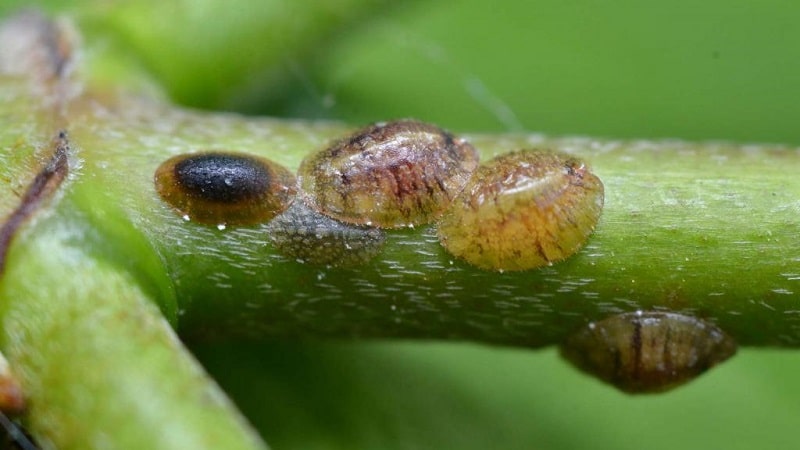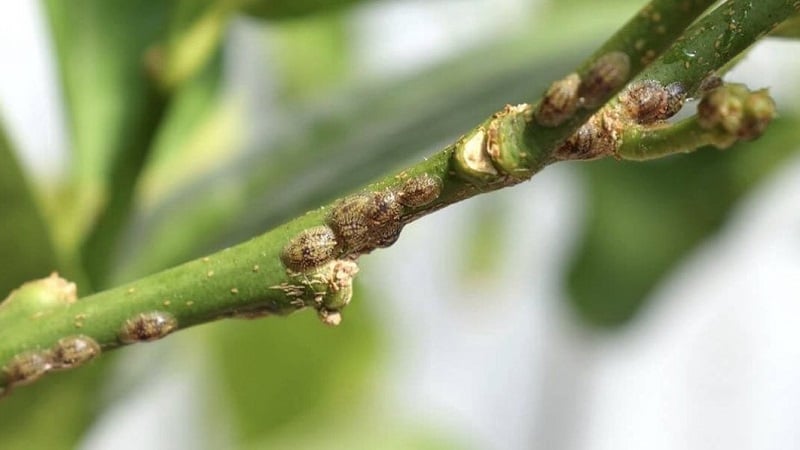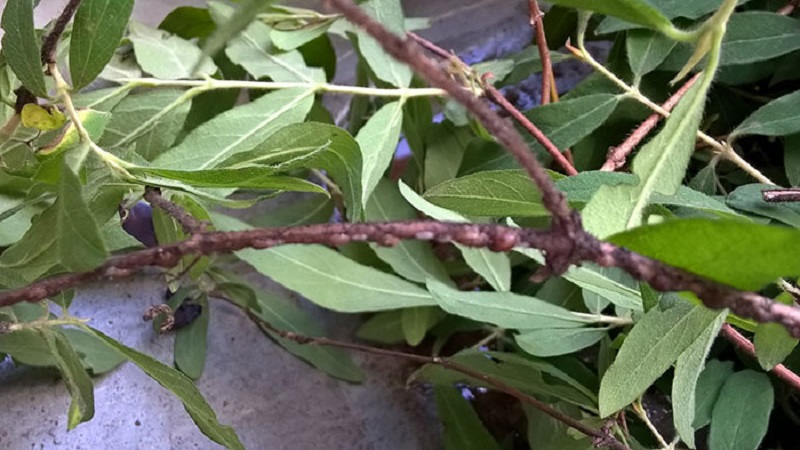How to deal with scale insects on honeysuckle easily and effectively
Scale insects are a dangerous pest that quickly attacks honeysuckle. It damages foliage, trunks, shoots and branches by sticking to them. To prevent reduction in yield and the death of the bush from related problems, it is necessary to familiarize yourself with control methods to destroy such a pest.
What kind of pest is this, what does it look like?
Scale insects are a small pest from the family of Homoptera insects. The body is covered with a shell or shield, hence the name of the parasite. It attaches to individual parts of the plant and sucks the juices out of them.

Females are larger and remain motionless most of the time. Males have a pair of wings and developed legs. The larvae lack a protective shell. The scale insect is easy to detect by its oval, slightly flattened body. It thickly covers the stems - outwardly it looks like brown formations.
Reference. Adults cling tightly to honeysuckle. Therefore, it is impossible to eliminate them mechanically.
Damage caused
Scale insects harm not only vegetation, but also berries. In addition, the liquid it secretes becomes an ideal breeding ground for sooty fungi.
The shrub becomes moldy, attracts other pests (for example, bark beetles, ants, aphids), and eventually dies. In this case, the situation will be extremely difficult.
Signs of honeysuckle being affected by scale insects
A careful examination of the bush, the underside of the leaf, and the places where the cuttings are attached to the branches reveals clutches of eggs. Dispersal occurs in the spring.In large crowds, individuals are located so closely that they are mistaken for a raid.
At the same time, yellowing of the foliage is observed, brown spots form on them, and they fall off prematurely. During the fruiting period, the scale insect is detected by yellowish and brown spots on the berries.
Interesting things on the site:
What worms spoil honeysuckle berries and how to get rid of them
Aphids on honeysuckle: how to treat so as not to destroy the crop
Types of scale insects
This insect creates a whole group of parasites, in which there are three main species. But the species of an individual pest does not in any way affect the choice of control methods.
Acacia false scale
Parthenolecaniiim corni Bouche are polyphagous insects that attack about 150 varieties and species of plants. Appear when the air temperature warms up to +9°C. The larvae settle on the bush and begin to suck out the sap.
Willow
Chionaspis salicis L. (pictured below) - These scale insects emerge as larvae in the spring. But they stick to the bark, thickly covering the stems. The result of their vital activity is the rapid weakening of honeysuckle. The scale insect has a light brown body, which turns dark brown as it matures.

Apple comma
Lepidosaphes ulmi L. is another species of polyphagous pest that feeds on thirty plant species. The branches and trunk become covered with brown spots, which leads to their drying out.
A large colony destroys the plant, and often the fight does not give positive results. The scale insect has an elongated body, slightly curved in the shape of a comma. It is considered the most dangerous insect in its family.
How to deal with them
In the early stages of honeysuckle damage, traditional methods are used.In large gatherings, including with adults, chemicals are used. But first things first.
Chemicals
Good drugs are:
- Admiral. It is a hormonal substance of contact-intestinal action. The composition includes pyriproxyfen, which has a detrimental effect on complex pests. 6 ml of the drug is diluted in 10 liters of water. The resulting solution is sprayed on honeysuckle early in the morning or in the evening. The procedure is repeated after two weeks.
- Aktara. A popular insecticide that acts on pests through the intestines. The main substance is thiamethoxam. 8 g of the drug is diluted in 10 liters of water. Shrubs are sprayed with the solution, using 2 liters for every 100 square meters of area. The procedure is repeated after two weeks.
- Actellik. Insectoacaricide acting through contact and intestines. Created on the basis of pirimiphos-methyl from the group of organophosphorus compounds. Quite toxic to humans. 4 ml of the drug is dissolved in 2 liters of water. Spraying is carried out in the spring before flowering begins, after fruiting ends.
- Apple. An insecticide that can destroy chitinous cover. 10 g of the drug is diluted in a bucket of water, and honeysuckle is sprayed with it. Particular attention is paid to heavily affected areas. If necessary, the measures are repeated after three weeks.
- Bankol. Based on bensultap. The working solution is prepared as follows: 50-70 g of the substance are diluted in 10 liters of water. Then the berry fields are sprayed, paying attention to neighboring bushes.
- Confidor Extra. 1 g of the drug is added to a bucket of water. Treat the affected areas once every two weeks. In case of severe damage, the amount of substance is doubled.
Attention! Experienced gardeners alternate the above chemicals at intervals of one or two weeks.For example, the first treatment is carried out with Admiral, and after 7 days - with Aktara. This really helps in killing not only the larvae, but also the adults.
During events, personal protective equipment is used. If it rained the next day, wait for stable sunny weather and spray the honeysuckle again.

Traditional methods
Such recipes are ineffective methods of combating scale insects. Remove as many pests as possible by hand, then destroy them. For better work, prepare a soap solution: dilute 30 ml of any liquid soap or pre-rubbed household bar, 20 ml of denatured alcohol in 2 liters of warm water. Using a brush, apply the solution to heavily affected areas, wait a while, and remove the pests.
Important! Many varieties of honeysuckle react negatively to alcohol. Therefore, before processing, they carry out a test: apply the composition to one sheet, if it has not turned yellow, calmly use alcohol on the remaining areas. If a burn occurs, the drug is applied exclusively to pests.
Features of the fight against scale insects during the fruiting period
At this time, chemicals are abandoned. Use only the folk method described above. If the bush could not be saved before the formation of berries, it is dug up and burned.
Preventive measures
Experienced gardeners prevent the appearance of scale insects in the following ways:
- for planting honeysuckle, choose a sunny place, since the insect loves shade and dampness;
- in a timely manner thin out the crown, removing dry and diseased branches;
- remove dead root shoots;
- adhere to the watering regime, apply only the necessary fertilizers.
Before purchasing, the seedling is carefully examined for the presence of characteristic signs of damage by scale insects. Avoid purchasing plants with rounded growths or rotten roots.
Read also:
How to properly care for honeysuckle in spring
Pests and diseases of honeysuckle: signs and methods of control
Conclusion
The scale insect is an extremely dangerous insect that can destroy honeysuckle in a short time. Pest control is difficult. But taking preventive measures can prevent its occurrence. Otherwise, you will have to use chemicals or completely remove the bushes from the site.